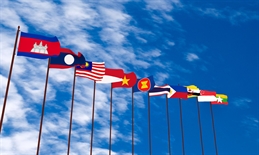
With the Asian economy set for zero growth this year, countries in the region are being urged to consider their future trade patterns and procedures.
There can be no doubting the scale of the problems the Covid-19 – and hopefully post-Covid – world will face.
“Asia’s growth rate in 2020 is expected to 0%,” Changyong Rhee, director of the International Monetary Fund’s Asia and Pacific department, told reporters attending a video press conference.
Asia has not experienced a zero-growth rate in the past 60 years – but its current growth still be far better than that of other regions.
“The U.S. growth rate is -5.9%; the Euro-area growth rate will be around -7.5%. And you can imagine what kind of impact this has on Asia’s export sector,” said Rhee. China, by contrast, will grow, but only by a meagre 1.2%, and that in the second half of the year, he added. ASEAN-5 growth is expected to be -1.3%.
Private sector sources corroborate this.
Ruben Gnanalingam, group managing director of Westports Malaysia, cautioned in a results statement that while Westports Q1 2020 container volumes were “only slightly lower, we expect the major effects of the Covid-19 pandemic to hit us in April and continue throughout the 2nd Quarter of 2020.”
Nor is there much more optimism beyond that.
“While we are hopeful for some recovery in the second half of the year, the company does not expect container throughput to register an overall increase for the year 2020.
The severity of the volume contraction would depend on how protracted the Covid-19 pandemic is going to be and how social and economic activities adjust to a post-lockdown world. The world is unlikely to be able to consume in the way it used to and it might take a while for it to get to the consumption levels of 2019,” Gnanalingam said.
Part of this is a concern that less money will mean less scope for investment in much-needed infrastructure. Some see it the other way, and argue that government money into big-ticket hardware is just the tonic for the post-Covid-19 economy.
Mohd Sheriff Mohd Kassim, a former secretary-general at the Malaysian Ministry of Finance and founder of the influential G25 lobby group, said three multi-billion ringgit projects – the East Coast Rail Link (ECRL), Kuala Lumpur-Singapore High Speed Rail (HSR) and National Fiberization and Connectivity Plan (NFCP) – could repair the economic damage caused by the pandemic.
It was reported in February that the RM44 billion (US$10.26 billion) ECRL, which will connect Port Klang and Kota Bharu, is only 15% complete.
Since the outbreak of the Covid-19 pandemic, it has begun to look as though the world may consume less than in pre-Covid-19 days, but it is looking likely we will consume and move differently – something in which ASEAN well might profit from, providing there is more integration, said CIMB ASEAN Research Institute (CARI) chairman Munir Majid at a recent online conference.
“There will be greater regionalization of the world, in which ASEAN is well-placed if it took its chances and truly established the ASEAN Economic Community, that single production base and market long promised but still fragmented by barriers and nationalist sentiment,” Majid said.
Specific though Majid’s point is, a more general one is the need to diversify post-Covid-19; regionalization is one option among that. For China, this might not be the most welcome news, as it could accelerate the shift of some types of manufacturing from China to ASEAN and elsewhere.
“We would suggest that the appropriate reaction would be to think over the current value chains that have been stretched across the globe,” Klaus-Jürgen Gern, senior manager of the international forecasting unit at the Kiel Institute for the World Economy, told Asia Cargo News.
This is not a call for reshoring – although that is one option. Gern’s view is that companies would do well to make their supply chains more resilient by moving away from overdependence on a single country or company. This could mean more or less globalization: “not necessarily only less,” he said.
There is an opportunity here for ASEAN countries, according to others, including Soon Ghee Chua, partner and head of the Southeast Asia unit at management consulting firm Kearney. China has a 28% share of global manufacturing, while ASEAN is only at 4%-5%, he said at the recent CARI conference.
“For those countries who are prepared with policy tools such as incentives and schemes, this will be a golden opportunity,” Chua said.
This might not be the best news for some in China, with a trade war looming irrespective of who wins the presidential election in the United States in November, rising labour costs and the country’s own financial problems looming. The aftermath of the Covid-19 pandemic might see some loss of China’s preeminence in the global value chain.
“China has already been on the way to losing a lot of its workbench factories to other Asian countries,” Gern told Asia Cargo News. “This process could be accelerated by corona because people think that a more diversified value chain is more appropriate, given these uncertainties.”
By Michael Mackey
Southeast Asia Correspondent | Bangkok




